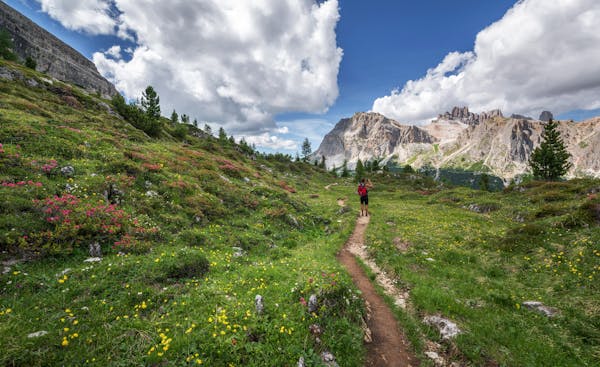Valley of Flowers Trek, Uttarakhand

Travel Ways (How to Reach)
The Valley of Flowers, a UNESCO World Heritage Site, is a stunning destination known for its diverse flora and breathtaking landscapes. Here are the ways to reach it:
- By Air: The nearest airport is Jolly Grant Airport in Dehradun, approximately 300 km away. From the airport, you can hire a taxi or take a bus to Joshimath, which serves as the base for the trek.
- By Train: The closest railway station is Haridwar, around 285 km from the Valley of Flowers. Regular trains connect Haridwar to major cities. From there, you can travel to Joshimath by taxi or bus.
- By Road: Kicking off your journey by road is a great option. Joshimath is accessible via well-maintained roads from various cities. You can drive or take a bus from Haridwar or Rishikesh to reach Joshimath.
Cloths Required
The weather in the Valley of Flowers can be unpredictable, so proper clothing is crucial:
- Warm Clothing: Layered clothing is recommended, including thermal wear, fleece jackets, and a waterproof outer layer for sudden rain.
- Trekking Shoes: Comfortable and sturdy trekking shoes with good traction are essential for the uneven terrain.
- Accessories: Woolen caps, gloves, and sunglasses will keep you warm and protect you from the sun.
- Rain Gear: A waterproof poncho or jacket is essential, especially during the monsoon season.
Fun Things to Do
The Valley of Flowers offers a unique experience for nature enthusiasts:
- Trekking: Explore the mesmerizing trekking trails, surrounded by vibrant flowers and stunning mountain views.
- Photography: Capture the stunning landscapes and unique flora; the valley is a paradise for photographers.
- Wildlife Watching: Keep an eye out for rare and endangered species like the Himalayan black bear and snow leopard.
- Visit Hemkund Sahib: A short trek from the valley leads to this revered Sikh pilgrimage site, offering spiritual solace amidst nature.
Places to Visit
In addition to the Valley of Flowers, there are several nearby attractions:
- Hemkund Sahib: A sacred site for Sikhs, set amidst a picturesque lake and surrounded by mountains.
- Govindghat: The starting point for the trek, known for its scenic beauty and as a base for pilgrims to Hemkund Sahib.
- Joshimath: A charming town with temples, markets, and beautiful views, serving as a base for various treks.
Famous Things to Do
Engage in experiences that highlight the beauty and culture of the region:
- Attend Local Festivals: Experience the vibrant culture during local festivals, showcasing traditional music and dance.
- Interact with Locals: Learn about the customs and traditions of the local communities, known for their hospitality.
- Explore Ancient Temples: Visit ancient temples in Joshimath, offering insights into the region's rich history.
Budget Analysis
Understanding the budget for your trip can help you plan better:
- Accommodation: Budget guesthouses range from ₹600 to ₹1,500 per night in Joshimath and nearby areas.
- Food: Meals at local eateries typically cost around ₹150-₹400, with options for various tastes.
- Transportation: Budget for local taxis and shared jeeps for reaching trek starting points and nearby attractions.
Trek Essentials
Ensure you pack the following essentials for your trek:
- Backpack: A comfortable, lightweight backpack to carry your essentials, ideally with good support.
- Water Bottle: Staying hydrated is crucial; carry a reusable water bottle to refill during your trek.
- Snacks: Energy bars, nuts, and dried fruits are great for quick energy boosts on the trail.
- First-Aid Kit: A basic kit including band-aids, antiseptic wipes, and any personal medications.
Duration to Spend
A typical trip to the Valley of Flowers may span 4-5 days:
- Day 1: Arrive in Joshimath and acclimatize; explore local attractions.
- Day 2: Trek to Ghangaria, the base for the Valley of Flowers, and settle in.
- Day 3: Explore the Valley of Flowers, taking in the vibrant landscapes.
- Day 4: Optional trek to Hemkund Sahib, then return to Ghangaria.
- Day 5: Return trek to Joshimath and prepare for departure.
Trek Distance
The trek from Ghangaria to the Valley of Flowers is approximately 3-4 km one way, making it suitable for most trekkers.
Difficulty Level
The trek is considered easy to moderate, suitable for beginners with basic fitness levels. However, some stretches may require caution due to uneven terrain.
Best Season to Visit
The ideal time to visit the Valley of Flowers is from late June to early September:
- Monsoon Season (June-September): This period brings the valley to life with blooming flowers, though expect occasional rainfall.
- Peak Bloom (July-August): The flowers are in full bloom, offering the best views and photography opportunities.
Hotel Rates and Stay Options
Accommodation in and around the Valley of Flowers is varied:
- Budget Options: Basic lodges and guesthouses in Ghangaria starting from ₹600 per night.
- Mid-Range Hotels: Comfortable stays ranging from ₹1,000 to ₹2,500 in Joshimath.
- Camping Options: For a more adventurous experience, consider camping in designated areas during the trek.
Food Rate
Food prices in the region are reasonable:
- Local Eateries: Meals typically cost around ₹150-₹300, with local cuisine available.
- Restaurants: Slightly upscale dining options may charge ₹300-₹600 per meal.
Medicines to Carry for Emergency
Be prepared for health emergencies with the following medications:
- Pain Relievers: Ibuprofen or paracetamol for headaches and body aches.
- Anti-Allergy Medication: For unexpected allergic reactions.
- Personal Prescriptions: Ensure you have any medications you regularly take.
- Basic First Aid Supplies: Band-aids, antiseptic wipes, and gauze for minor injuries.
About the Place
The Valley of Flowers National Park, located in Uttarakhand, is renowned for its stunning alpine flora, diverse wildlife, and picturesque landscapes. It is a paradise for nature lovers and trekkers alike.
History and Mythology
The valley was discovered in 1931 by British mountaineers Frank Smythe and his team while they were on an expedition. Since then, it has been recognized for its unique ecosystem and biodiversity, attracting visitors from around the globe.
Comments
Post a Comment